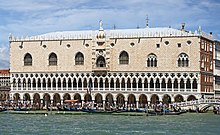
Venetian Gothic is the particular form of Italian Gothic architecture typical of Venice, originating in local building requirements, with some influence from Byzantine architecture, and some from Islamic architecture, reflecting Venice's trading network. Very unusually for medieval architecture, the style is at its most characteristic in secular buildings, with the great majority of surviving examples of the style being secular.
The best-known examples are the Doge's Palace and the Ca' d'Oro. Both feature loggias of closely spaced small columns, with heavy tracery with quatrefoil openings above, decoration along the roofline, and some coloured patterning to plain wall surfaces. Together with the ogee arch, capped with a relief ornament, and ropework reliefs, these are the most iconic characteristics of the style. Ecclesiastical Gothic architecture tended to be less distinctively Venetian, and closer to that in the rest of Italy.
The beginning of the style probably goes back no further than the 13th century, although the dates of early Gothic palaces, and especially features such as windows in them, are largely uncertain. It dominated the 14th century and because of the city's conservatism Venetian Gothic buildings, especially smaller palaces, continued to be built well into the second half of the 15th century,[1] and Venetian Renaissance architecture very often retained reminiscences of its Gothic predecessor.

In the 19th century, inspired in particular by the writings of John Ruskin,[2] there was a revival of the style, part of the broader Gothic Revival movement in Victorian architecture. Even in the Middle Ages, Venetian palaces were built on very constricted sites, and were tall rectangular boxes with decoration concentrated on the front facade. The style was therefore developed for a similar architectural context to that found in late 19th-century city centre streets.